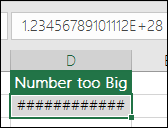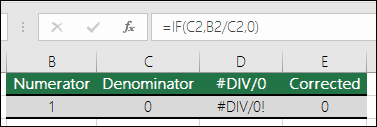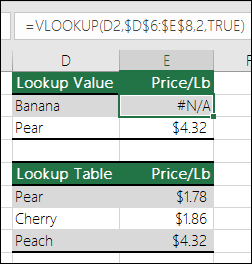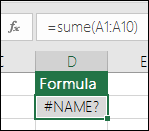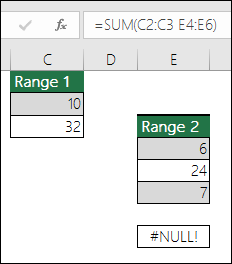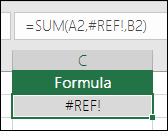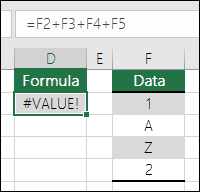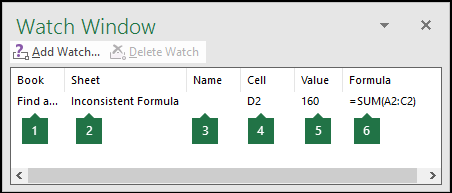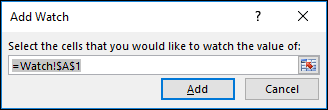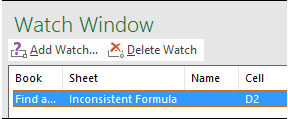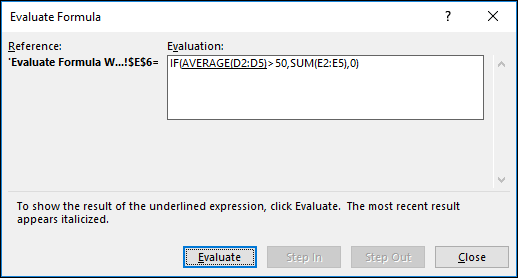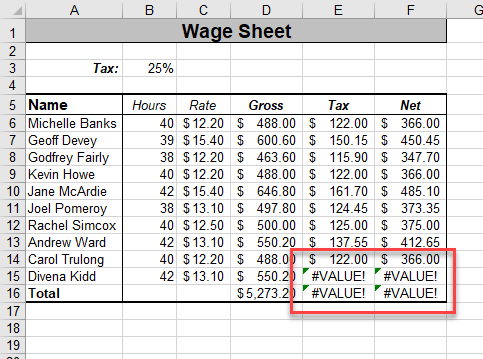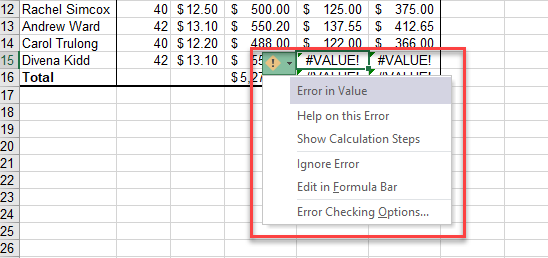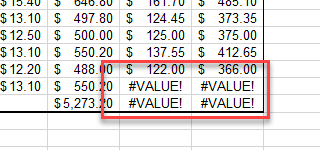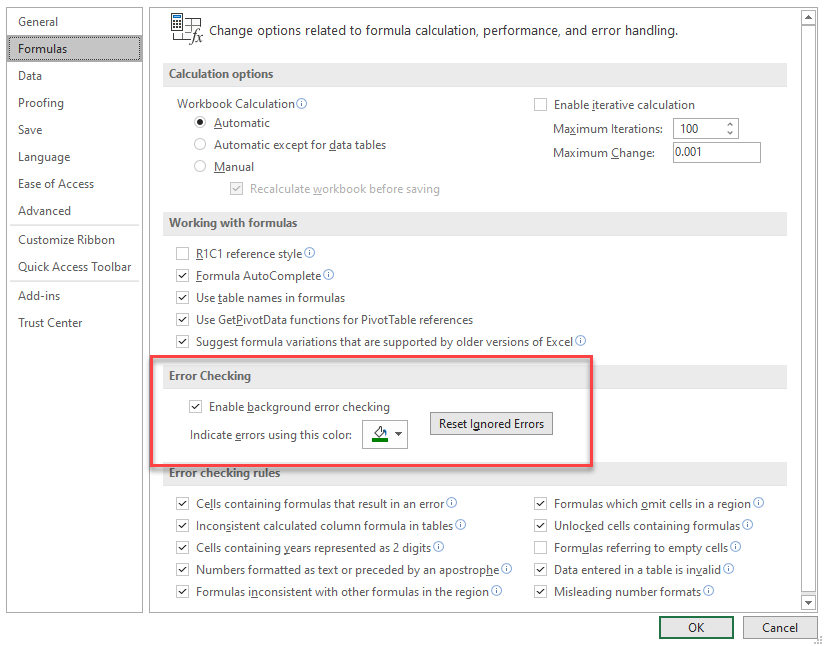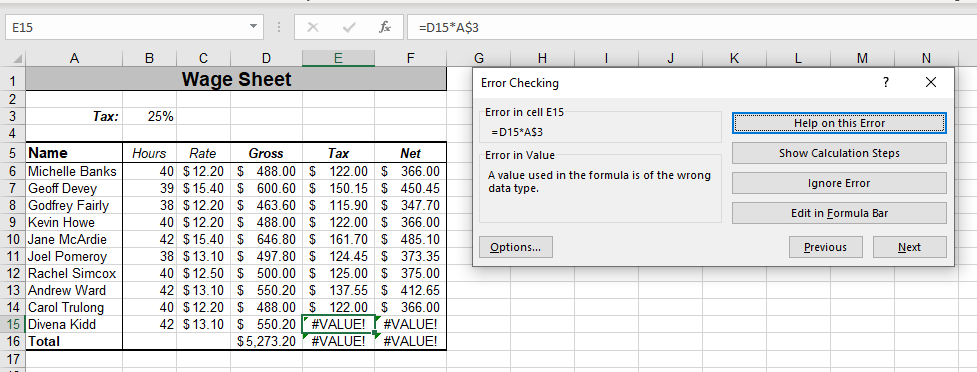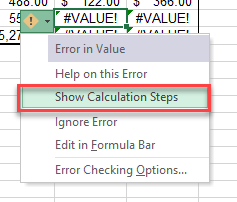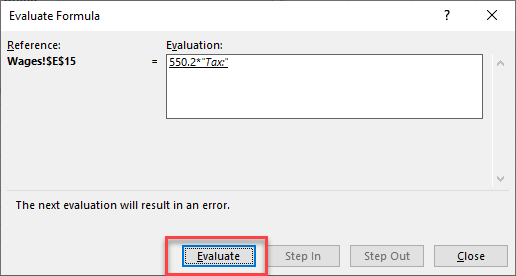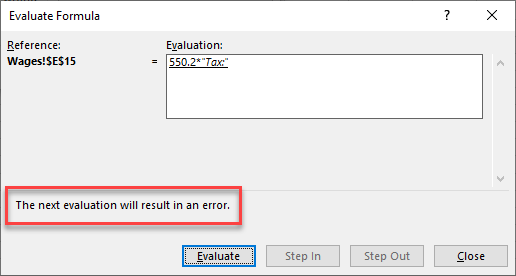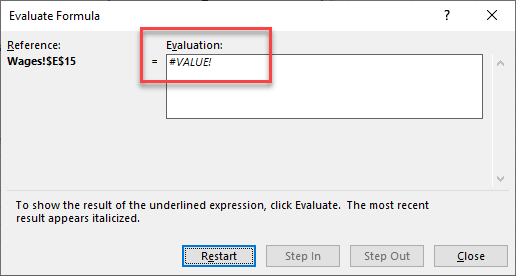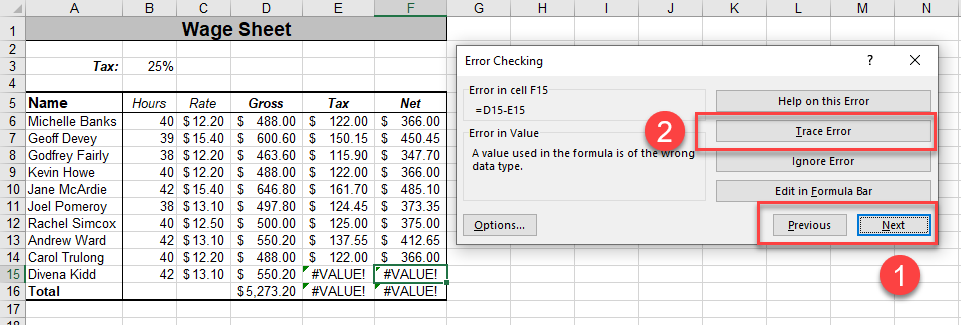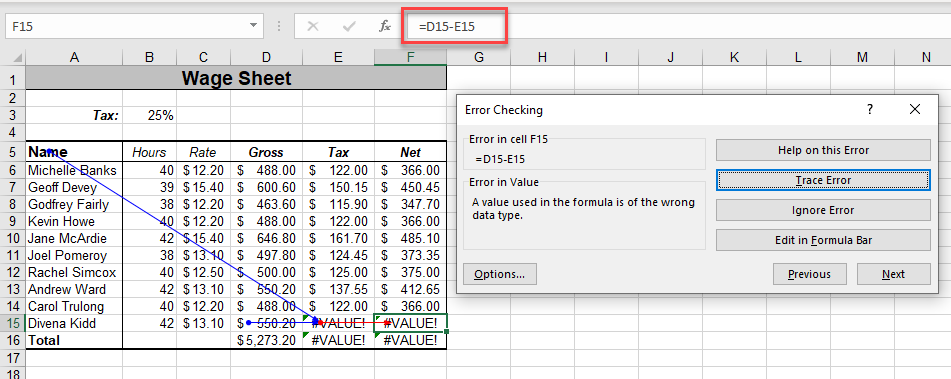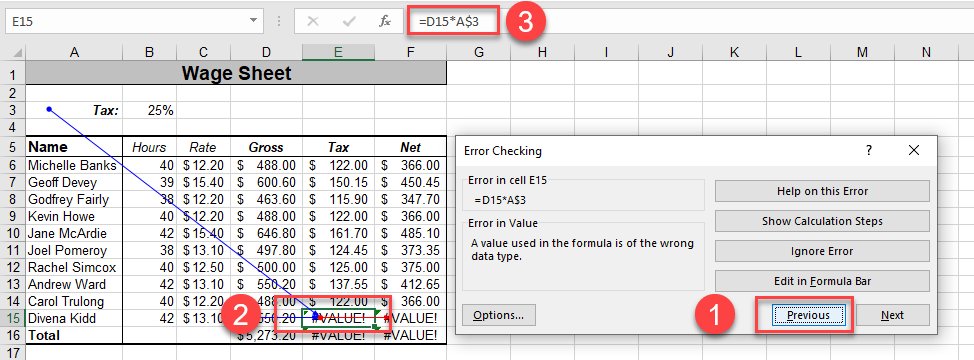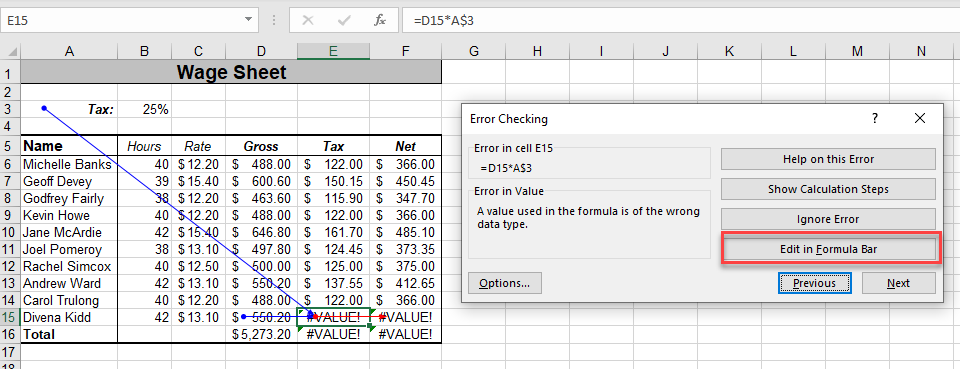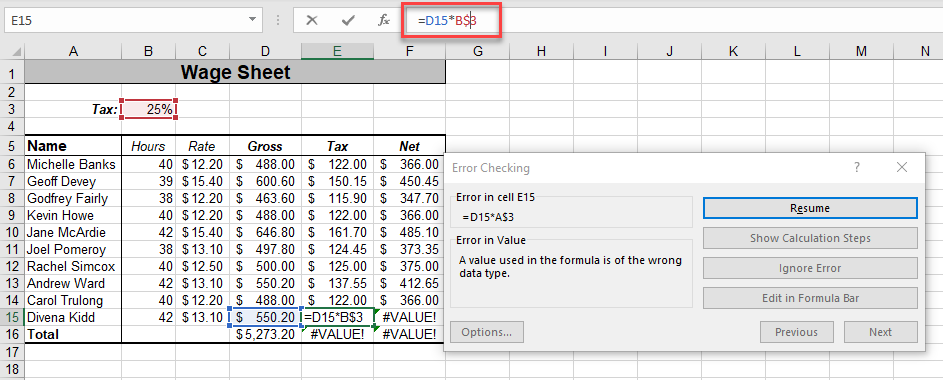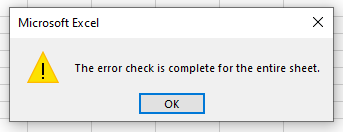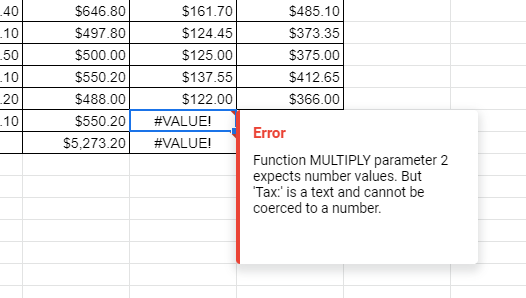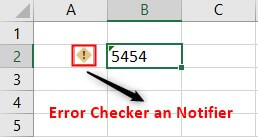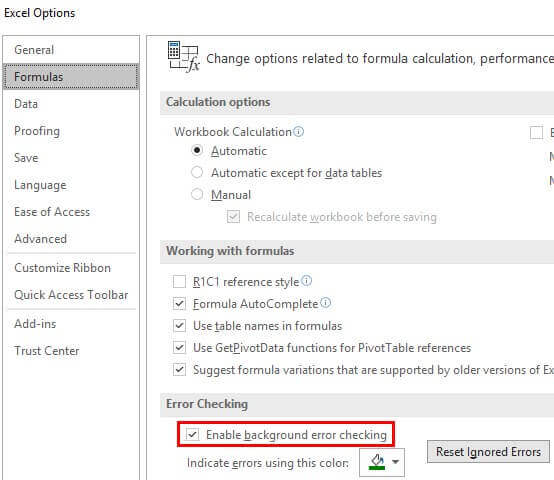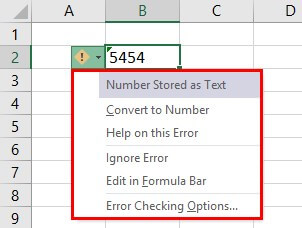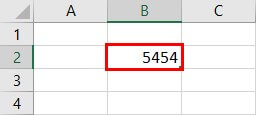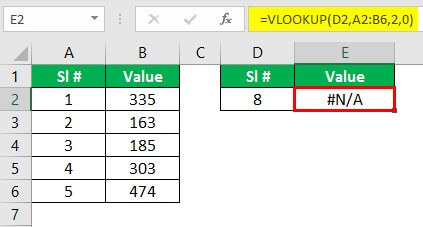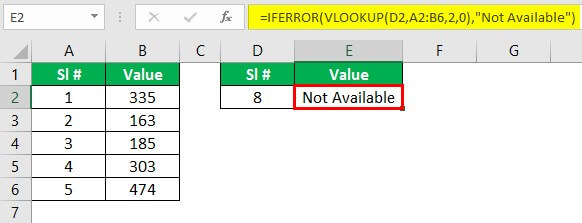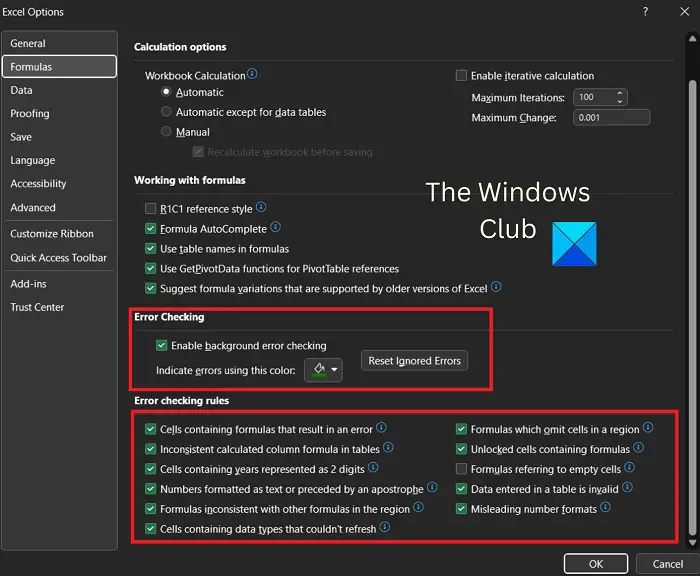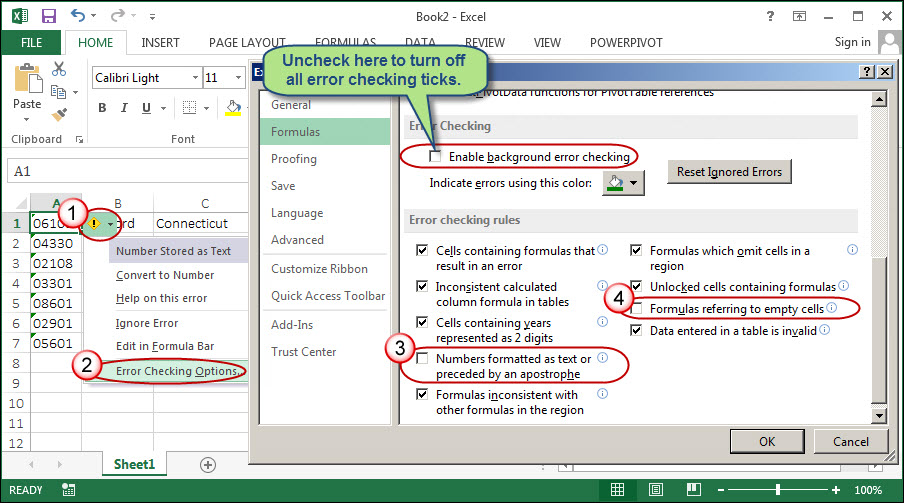Excel for Microsoft 365 Excel for Microsoft 365 for Mac Excel 2021 Excel 2021 for Mac Excel 2019 Excel 2019 for Mac Excel 2016 Excel 2016 for Mac Excel 2013 Excel 2010 Excel 2007 Excel for Mac 2011 Excel Starter 2010 More…Less
Formulas can sometimes result in error values in addition to returning unintended results. The following are some tools that you can use to find and investigate the causes of these errors and determine solutions.
Note: This topic contains techniques that can help you correct formula errors. It is not an exhaustive list of methods for correcting every possible formula error. For help on specific errors, you can search for questions like yours in the Excel Community Forum, or post one of your own.
Learn how to enter a simple formula
Formulas are equations that perform calculations on values in your worksheet. A formula starts with an equal sign (=). For example, the following formula adds 3 to 1.
=3+1
A formula can also contain any or all of the following: functions, references, operators, and constants.
Parts of a formula
-
Functions: included with Excel, functions are engineered formulas that carry out specific calculations. For example, the PI() function returns the value of pi: 3.142…
-
References: refer to individual cells or ranges of cells. A2 returns the value in cell A2.
-
Constants: numbers or text values entered directly into a formula, such as 2.
-
Operators: The ^ (caret) operator raises a number to a power, and the * (asterisk) operator multiplies. Use + and – add and subtract values, and / to divide.
Note: Some functions require what are referred to as arguments. Arguments are the values that certain functions use to perform their calculations. When required, arguments are placed between the function’s parentheses (). The PI function does not require any arguments, which is why it’s blank. Some functions require one or more arguments, and can leave room for additional arguments. You need to use a comma to separate arguments, or a semi-colon (;) depending on your location settings.
The SUM function for example, requires only one argument, but can accommodate 255 total arguments.
=SUM(A1:A10) is an example of a single argument.
=SUM(A1:A10, C1:C10) is an example of multiple arguments.
The following table summarizes some of the most common errors that a user can make when entering a formula, and explains how to correct them.
|
Make sure that you |
More information |
|
Start every function with the equal sign (=) |
If you omit the equal sign, what you type may be displayed as text or as a date. For example, if you type SUM(A1:A10), Excel displays the text string SUM(A1:A10) and does not perform the calculation. If you type 11/2, Excel displays the date 2-Nov (assuming the cell format is General) instead of dividing 11 by 2. |
|
Match all open and closing parentheses |
Make sure that all parentheses are part of a matching pair (opening and closing). When you use a function in a formula, it is important for each parenthesis to be in its correct position for the function to work correctly. For example, the formula =IF(B5<0),»Not valid»,B5*1.05) will not work because there are two closing parentheses and only one open parenthesis, when there should only be one each. The formula should look like this: =IF(B5<0,»Not valid»,B5*1.05). |
|
Use a colon to indicate a range |
When you refer to a range of cells, use a colon (:) to separate the reference to the first cell in the range and the reference to the last cell in the range. For example, =SUM(A1:A5), not =SUM(A1 A5), which would return a #NULL! Error. |
|
Enter all required arguments |
Some functions have required arguments. Also, make sure that you have not entered too many arguments. |
|
Enter the correct type of arguments |
Some functions, such as SUM, require numerical arguments. Other functions, such as REPLACE, require a text value for at least one of their arguments. If you use the wrong type of data as an argument, Excel may return unexpected results or display an error. |
|
Nest no more than 64 functions |
You can enter, or nest, no more than 64 levels of functions within a function. |
|
Enclose other sheet names in single quotation marks |
If a formula refers to values or cells on other worksheets or workbooks, and the name of the other workbook or worksheet contains spaces or non-alphabetical characters, you must enclose its name within single quotation marks ( ‘ ), like =’Quarterly Data’!D3, or =‘123’!A1. |
|
Place an exclamation point (!) after a worksheet name when you refer to it in a formula |
For example, to return the value from cell D3 in a worksheet named Quarterly Data in the same workbook, use this formula: =’Quarterly Data’!D3. |
|
Include the path to external workbooks |
Make sure that each external reference contains a workbook name and the path to the workbook. A reference to a workbook includes the name of the workbook and must be enclosed in brackets ([Workbookname.xlsx]). The reference must also contain the name of the worksheet in the workbook. If the workbook that you want to refer to is not open in Excel, you can still include a reference to it in a formula. You provide the full path to the file, such as in the following example: =ROWS(‘C:My Documents[Q2 Operations.xlsx]Sales’!A1:A8). This formula returns the number of rows in the range that includes cells A1 through A8 in the other workbook (8). Note: If the full path contains space characters, as does the preceding example, you must enclose the path in single quotation marks (at the beginning of the path and after the name of the worksheet, before the exclamation point). |
|
Enter numbers without formatting |
Do not format numbers when you enter them in formulas. For example, if the value that you want to enter is $1,000, enter 1000 in the formula. If you enter a comma as part of a number, Excel treats it as a separator character. If you want numbers displayed so that they show thousands or millions separators, or currency symbols, format the cells after you enter the numbers. For example, if you want to add 3100 to the value in cell A3, and you enter the formula =SUM(3,100,A3), Excel adds the numbers 3 and 100 and then adds that total to the value from A3, instead of adding 3100 to A3 which would be =SUM(3100,A3). Or, if you enter the formula =ABS(-2,134), Excel displays an error because the ABS function accepts only one argument: =ABS(-2134). |
You can implement certain rules to check for errors in formulas. These rules do not guarantee that your worksheet is error free, but they can go a long way toward finding common mistakes. You can turn any of these rules on or off individually.
Errors can be marked and corrected in two ways: one error at a time (like a spell checker), or immediately when they occur on the worksheet as you enter data.
You can resolve an error by using the options that Excel displays, or you can ignore the error by clicking Ignore Error. If you ignore an error in a particular cell, the error in that cell does not appear in further error checks. However, you can reset all previously ignored errors so that they appear again.
-
For Excel on Windows, Click File > Options > Formulas, or
for Excel on Mac, click the Excel menu > Preferences > Error Checking.In Excel 2007, click the Microsoft Office button
> Excel Options > Formulas.
-
Under Error Checking, check Enable background error checking. Any error that is found, will be marked with a triangle in the top-left corner of the cell.
-
To change the color of the triangle that marks where an error occurs, in the Indicate errors using this color box, select the color that you want.
-
Under Excel checking rules, select or clear the check boxes of any of the following rules:
-
Cells containing formulas that result in an error: A formula does not use the expected syntax, arguments, or data types. Error values include #DIV/0!, #N/A, #NAME?, #NULL!, #NUM!, #REF!, and #VALUE!. Each of these error values have different causes and are resolved in different ways.
Note: If you enter an error value directly in a cell, it is stored as that error value but is not marked as an error. However, if a formula in another cell refers to that cell, the formula returns the error value from that cell.
-
Inconsistent calculated column formula in tables: A calculated column can include individual formulas that are different from the master column formula, which creates an exception. Calculated column exceptions are created when you do any of the following:
-
Type data other than a formula in a calculated column cell.
-
Type a formula in a calculated column cell, and then use Ctrl +Z or click Undo
on the Quick Access Toolbar.
-
Type a new formula in a calculated column that already contains one or more exceptions.
-
Copy data into the calculated column that does not match the calculated column formula. If the copied data contains a formula, this formula overwrites the data in the calculated column.
-
Move or delete a cell on another worksheet area that is referenced by one of the rows in a calculated column.
-
-
Cells containing years represented as 2 digits: The cell contains a text date that can be misinterpreted as the wrong century when it is used in formulas. For example, the date in the formula =YEAR(«1/1/31») could be 1931 or 2031. Use this rule to check for ambiguous text dates.
-
Numbers formatted as text or preceded by an apostrophe: The cell contains numbers stored as text. This typically occurs when data is imported from other sources. Numbers that are stored as text can cause unexpected sorting results, so it is best to convert them to numbers. ‘=SUM(A1:A10) is seen as text.
-
Formulas inconsistent with other formulas in the region: The formula does not match the pattern of other formulas near it. In many cases, formulas that are adjacent to other formulas differ only in the references used. In the following example of four adjacent formulas, Excel displays an error next to the formula =SUM(A10:C10) in cell D4 because the adjacent formulas increment by one row, and that one increments by 8 rows — Excel expects the formula =SUM(A4:C4).
If the references that are used in a formula are not consistent with those in the adjacent formulas, Excel displays an error.
-
Formulas which omit cells in a region: A formula may not automatically include references to data that you insert between the original range of data and the cell that contains the formula. This rule compares the reference in a formula against the actual range of cells that is adjacent to the cell that contains the formula. If the adjacent cells contain additional values and are not blank, Excel displays an error next to the formula.
For example, Excel inserts an error next to the formula =SUM(D2:D4) when this rule is applied, because cells D5, D6, and D7 are adjacent to the cells that are referenced in the formula and the cell that contains the formula (D8), and those cells contain data that should have been referenced in the formula.
-
Unlocked cells containing formulas: The formula is not locked for protection. By default, all cells on a worksheet are locked so they can’t be changed when the worksheet is protected. This can help avoid inadvertent mistakes like accidentally deleting or altering formulas. This error indicates that the cell has been set to be unlocked, but the sheet has not been protected. Check to make sure that you do not want the cell locked or not.
-
Formulas referring to empty cells: The formula contains a reference to an empty cell. This can cause unintended results, as shown in the following example.
Suppose you want to calculate the average of the numbers in the following column of cells. If the third cell is blank, it is not included in the calculation and the result is 22.75. If the third cell contains 0, the result is 18.2.
-
Data entered in a table is invalid: There is a validation error in a table. Check the validation setting for the cell by going to the Data tab > Data Tools group > Data Validation.
-
-
Select the worksheet you want to check for errors.
-
If the worksheet is manually calculated, press F9 to recalculate.
If the Error Checking dialog is not displayed, then click on the Formulas tab > Formula Auditing > Error Checking button.
-
If you have previously ignored any errors, you can check for those errors again by doing the following: click File > Options > Formulas. For Excel on Mac, click the Excel menu > Preferences > Error Checking.
In the Error Checking section, click Reset Ignored Errors > OK.
Note: Resetting ignored errors resets all errors in all sheets in the active workbook.
Tip: It might help if you move the Error Checking dialog box just below the formula bar.
-
Click one of the action buttons in the right side of the dialog box. The available actions differ for each type of error.
-
Click Next.
Note: If you click Ignore Error, the error is marked to be ignored for each consecutive check.
-
Next to the cell, click the Error Checking button
that appears, and then click the option you want. The available commands differ for each type of error, and the first entry describes the error.
If you click Ignore Error, the error is marked to be ignored for each consecutive check.
If a formula cannot correctly evaluate a result, Excel displays an error value, such as #####, #DIV/0!, #N/A, #NAME?, #NULL!, #NUM!, #REF!, and #VALUE!. Each error type has different causes, and different solutions.
The following table contains links to articles that describe these errors in detail, and a brief description to get you started.
|
Topic |
Description |
|
Correct a #### error |
Excel displays this error when a column is not wide enough to display all the characters in a cell, or a cell contains negative date or time values. For example, a formula that subtracts a date in the future from a date in the past, such as =06/15/2008-07/01/2008, results in a negative date value. Tip: Try to auto-fit the cell by double-clicking between the column headers. If ### is displayed because Excel can’t display all of the characters this will correct it. |
|
Correct a #DIV/0! error |
Excel displays this error when a number is divided either by zero (0) or by a cell that contains no value. Tip: Add an error handler like in the following example, which is =IF(C2,B2/C2,0) |
|
Correct a #N/A error |
Excel displays this error when a value is not available to a function or formula. If you’re using a function like VLOOKUP, does what you’re trying to lookup have a match in the lookup range? Most often it doesn’t. Try using IFERROR to suppress the #N/A. In this case you could use: =IFERROR(VLOOKUP(D2,$D$6:$E$8,2,TRUE),0) |
|
Correct a #NAME? error |
This error is displayed when Excel does not recognize text in a formula. For example, a range name or the name of a function may be spelled incorrectly. Note: If you’re using a function, make sure the function name is spelled correctly. In this case SUM is spelled incorrectly. Remove the “e” and Excel will correct it. |
|
Correct a #NULL! error |
Excel displays this error when you specify an intersection of two areas that do not intersect (cross). The intersection operator is a space character that separates references in a formula. Note: Make sure your ranges are correctly separated — the areas C2:C3 and E4:E6 do not intersect, so entering the formula =SUM(C2:C3 E4:E6) returns the #NULL! error. Putting a comma between the C and E ranges will correct it =SUM(C2:C3,E4:E6) |
|
Correct a #NUM! error |
Excel displays this error when a formula or function contains invalid numeric values. Are you using a function that iterates, such as IRR or RATE? If so, the #NUM! error is probably because the function can’t find a result. Refer to the help topic for resolution steps. |
|
Correct a #REF! error |
Excel displays this error when a cell reference is not valid. For example, you may have deleted cells that were referred to by other formulas, or you may have pasted cells that you moved on top of cells that were referred to by other formulas. Did you accidentally delete a row or column? We deleted column B in this formula, =SUM(A2,B2,C2), and look what happened. Either use Undo (Ctrl+Z) to undo the deletion, rebuild the formula, or use a continuous range reference like this: =SUM(A2:C2), which would have automatically updated when column B was deleted. |
|
Correct a #VALUE! error |
Excel can display this error if your formula includes cells that contain different data types. Are you using Math operators (+, -, *, /, ^) with different data types? If so, try using a function instead. In this case =SUM(F2:F5) would correct the problem. |
When cells are not visible on a worksheet, you can watch those cells and their formulas in the Watch Window toolbar. The Watch Window makes it convenient to inspect, audit, or confirm formula calculations and results in large worksheets. By using the Watch Window, you don’t need to repeatedly scroll or go to different parts of your worksheet.
This toolbar can be moved or docked like any other toolbar. For example, you can dock it on the bottom of the window. The toolbar keeps track of the following cell properties: 1) Workbook, 2) Sheet, 3) Name (if the cell has a corresponding Named Range), 4) Cell address, 5) Value, and 6) Formula.
Note: You can have only one watch per cell.
Add cells to the Watch Window
-
Select the cells that you want to watch.
To select all cells on a worksheet with formulas, on the Home tab, in the Editing group, click Find & Select (or you can use Ctrl+G, or Control+G on the Mac)> Go To Special > Formulas.
-
On the Formulas tab, in the Formula Auditing group, click Watch Window.
-
Click Add Watch.
-
Confirm that you have selected all of the cells you want to watch and click Add.
-
To change the width of a Watch Window column, drag the boundary on the right side of the column heading.
-
To display the cell that an entry in Watch Window toolbar refers to, double-click the entry.
Note: Cells that have external references to other workbooks are displayed in the Watch Window toolbar only when the other workbooks are open.
Remove cells from the Watch Window
-
If the Watch Window toolbar is not displayed, on the Formulas tab, in the Formula Auditing group, click Watch Window.
-
Select the cells that you want to remove.
To select multiple cells, press CTRL and then click the cells.
-
Click Delete Watch.
Sometimes, understanding how a nested formula calculates the final result is difficult because there are several intermediate calculations and logical tests. However, by using the Evaluate Formula dialog box, you can see the different parts of a nested formula evaluated in the order the formula is calculated. For example, the formula =IF(AVERAGE(D2:D5)>50,SUM(E2:E5),0)is easier to understand when you can see the following intermediate results:
|
In the Evaluate Formula dialog box |
Description |
|
=IF(AVERAGE(D2:D5)>50,SUM(E2:E5),0) |
The nested formula is initially displayed. The AVERAGE function and the SUM function are nested within the IF function. The cell range D2:D5 contains the values 55, 35, 45, and 25, and so the result of the AVERAGE(D2:D5) function is 40. |
|
=IF(40>50,SUM(E2:E5),0) |
The cell range D2:D5 contains the values 55, 35, 45, and 25, and so the result of the AVERAGE(D2:D5) function is 40. |
|
=IF(False,SUM(E2:E5),0) |
Because 40 is not greater than 50, the expression in the first argument of the IF function (the logical_test argument) is False. The IF function returns the value of the third argument (the value_if_false argument). The SUM function is not evaluated because it is the second argument to the IF function (value_if_true argument), and it is returned only when the expression is True. |
-
Select the cell that you want to evaluate. Only one cell can be evaluated at a time.
-
Select the Formulas tab > Formula Auditing > Evaluate Formula.
-
Click Evaluate to examine the value of the underlined reference. The result of the evaluation is shown in italics.
If the underlined part of the formula is a reference to another formula, click Step In to display the other formula in the Evaluation box. Click Step Out to go back to the previous cell and formula.
The Step In button is not available for a reference the second time the reference appears in the formula, or if the formula refers to a cell in a separate workbook.
-
Continue clicking Evaluate until each part of the formula has been evaluated.
-
To see the evaluation again, click Restart.
-
To end the evaluation, click Close.
Notes:
-
Some parts of formulas that use the IF and CHOOSE functions are not evaluated — in these cases, #N/A is displayed in the Evaluation box.
-
If a reference is blank, a zero value (0) is displayed in the Evaluation box.
-
The following functions are recalculated each time the worksheet changes, and can cause the Evaluate Formula dialog box to give results different from what appears in the cell: RAND, AREAS, INDEX, OFFSET, CELL, INDIRECT, ROWS, COLUMNS, NOW, TODAY, RANDBETWEEN.
Need more help?

You can always ask an expert in the Excel Tech Community or get support in the Answers community.
See Also
Display the relationships between formulas and cells
How to avoid broken formulas
Need more help?
See all How-To Articles
This tutorial will demonstrate how to use Error Checking in Excel and Google Sheets.
Background Error Checking
Errors in Excel formulas usually show up as a small green triangle in the top left-hand corner of a cell. If you click in the cell that contains an error, a drop down list is enabled from which you can select the option you require.
If the background error checking options are not switched on in Excel, then this triangle will not show up, but the cell will still contain an error value.
In order to ensure you see the triangle, which makes error checking easier, make sure background checking is switched on in Excel options.
1. In the Ribbon, select File. Then select Options > Formulas.
2. Make sure the check-mark “Enable background error checking” is checked and then click OK. (Usually, this is already checked by default in Excel.)
How to Use Error Checking
1. With the file that contains the errors open in Excel, in the Ribbon, select Formula > Formula Auditing > Error Checking.
2. In the Error Checking dialog box, click Show Calculation Steps.
OR
Click on the small green triangle in the left-hand side of the cell that contains the error, and select Show Calculation Steps.
3. Click Evaluate to evaluate the error.
4. Keep clicking evaluate until you get the message: “The next evaluation will result in an error.”
The error is shown in the formula in the dialog box.
5. Click Close, and then (1) click Next to move to the next error. Then (2) click Trace to trace the error.
Excel will highlight the error with tracing arrows allowing you to see where the error is originating from. In this case, the #VALUE in the error is coming from the #VALUE in the previous error but the formula in the formula bar looks fine.
6. Click (1) Previous to move to the previous error. The cell pointer will in this case (2) move to E15. The formula in E15 is shown (3) in the formula bar. Here, you can see that the formula is multiplying a value (e.g., in D15) with text (e.g., in A3).
7. Click Edit in Formula bar.
8. Amend the formula as appropriate, and then click Resume.
If all the errors in the worksheet are fixed, Error Checking will stop.
This example showed #VALUE errors, but Error Checking will find all # errors. There is a different option for circular references.
Error Checking in Google Sheets
Error checking is automatic in Google Sheets. As soon as you have a cell that contains an error, it will show up on the screen with details about the error.
Errors are quite common. You will not find a single person who does not make any errors in Excel. When the errors are part and parcel of Excel, one must know how to find those errors and resolve those issues.
When using Excel routinely, we may encounter many errors flagged if the error handler is enabled. Otherwise, we may get potential calculation errors. So if you are new to error handling in Excel, this article is a perfect guide for you.
Table of contents
- How to Find Errors in Excel?
- Find and Handle Errors in Excel
- Example #1 – Error Handling through Error Handler
- Example #2 – Formulas Error Handling
- Things to Remember
- Recommended Articles
- Find and Handle Errors in Excel
Find and Handle Errors in Excel
You can download this Error Checking Excel Template here – Error Checking Excel Template
Whenever an Excel cell encounters an error, it will, by default, display the error through the error handler. The error handler in Excel is a built-in tool. We can enable this using this and get the full benefit of it.
As we can see in the above image, we have an error notifier showing that there is an error with the cell B2 value.
You also must have come across this error handler in Excel but are not aware of this. If the Excel worksheet does not show this error handling message, we must enable this by following the below steps:
- We must first click on the “File” tab in the ribbon.
- Under the “File” tab, click on “Options.”
- It will open the “Excel Options” window. Next, click on the “Formulas” tab.
- Under “Error Checking,” check the “Enable background error checking” box.
At the bottom, we can choose the color which can notify the error. The green color has been selected by default, but we can change this.
Example #1 – Error Handling through Error Handler
When the data format is not proper, we may get errors. So in those scenarios, in that particular cell, we may see that error notification.
- For example, look at the below image of an error.
When we place our cursor on that error handler, it shows the message, “The number in this cell is formatted as text or preceded by an apostrophe.”
- To fix this error, we must click on the drop-down listA drop-down list in excel is a pre-defined list of inputs that allows users to select an option.read more of the icon, and we see the below options.
- The first displays “Number Stored as Text,” which is the error. To fix this excel errorErrors in excel are common and often occur at times of applying formulas. The list of nine most common excel errors are — #DIV/0, #N/A, #NAME?, #NULL!, #NUM!, #REF!, #VALUE!, #####, Circular Reference.read more, look at the second option. The “Convert to Number” mentions clicking on these options. Therefore, it will solve the error.
Now, look at the cell. It has no error message icon now. Like this, we can fix data format-related errors easily.
Example #2 – Formulas Error Handling
Formulas often return an error. To deal with those errors, we need to employ a different strategy. Before handling the error, we need to look at the kind of errors we encounter in different scenarios.
Below are the kind of errors we see in Excel.
- #DIV/0! – If the number is divided by 0 or an empty cell, we may get the #DIV/0 error#DIV/0! is the division error in Excel which occurs every time a number is divided by zero. Simply put, we get this error when we divide any number by an empty or zero-value cell.read more.
- #N/A – If the VLOOKUP formula does not find a value, then we get this error.
- #NAME? – If the formula name is not recognized, we get this error.
- #REF! – When the formula reference cell is deleted, or the formula reference area is out of range, we may get this #REF! Error.
- #VALUE! – When wrong data types are included in the formula, we may get the #VALUE! Error#VALUE! Error in Excel represents that the reference cell the user has either entered an incorrect formula or used a wrong data type (mostly numerical data). Sometimes, it is difficult to identify the kind of mistake behind this error.read more.
So, to deal with the above error values, we need to use the IFERROR functionThe IFERROR function in Excel checks a formula (or a cell) for errors and returns a specified value in place of the error.read more.
- For example, look at the below formula image.
The VLOOKUP formula has been applied. However, the LOOKUP value “8” is not mentioned in the “Table Array” range A2 to B6, so the VLOOKUP returns an error value as #N/A, i.e., not available error.
- To fix this error, we must use the IFERROR function.
Before using the VLOOKUP function, we used the IFERROR function. If the VLOOKUP function returns an error instead of a result, the IFERROR function returns the alternative outcome, “Not Available,” instead of the traditional #N/A error result.
Like this, we can handle errors in Excel.
Things to Remember
- The error notifier will show an error icon if the cell value data type is unsuitable.
- The IFERROR function is typically used to check formula errors.
Recommended Articles
This article is a guide to Finding Errors in Excel. Here, we discuss finding and handling errors in Excel, practical examples, and a downloadable Excel template. You may learn more about financing from the following articles: –
- Error Bars in Excel
- Formula Errors in Excel
- IFERROR with VLOOKUP in Excel
- Excel Test
The real power of Microsoft Excel lies in its formulae. However, as a Microsoft Excel user would know well, making mistakes with formulae are common since they are complicated. You can fix this by tracing these errors and checking suggestions for improvements. This is called Background error checking. We will show you the procedure to enable or disable the same.
What is Background error checking in Excel?
Microsoft Excel is not only about arranging data in sheets. The real purpose of the software is to make calculations. Microsoft Excel is used to create information out of random data. Formulae are used for this purpose. Since formulae in Microsoft Excel can get very complicated, it is important to check them for errors. When Microsoft Excel does this process automatically in the background, then it is called Background error checking.
Background error checking is enabled on Microsoft Excel by default. However, if a third-party extension disabled it or another user disabled the option, it can be re-enabled again as follows:
- Launch Excel
- Click on File.
- From the menu, select Options.
- Go to the Formulas tab.
- In the Error checking section, check the box associated with Enable background error checking.
- If you wish to disable Background error checking, then simply uncheck the box.
- Click on OK to save the settings.
If the enabling or disabling or Background error checking is caused due to a third-party extension, you will have to disable the same.
How to change the color for Background error checking in Excel?
The color for errors marked through the Background error checking process are all green. This is because green is the default color for these marked errors. You can change this color as well. The procedure is as follows:
- Go to the Formulas window as explained earlier.
- In the Error checking group, you will find an option for Indicate error using this color.
- Change the color from the drop-down menu.
How to reset Ignored errors in Microsoft Excel?
The Background error-checking process marks errors as per a set procedure. Many errors marked by the process could be genuine formulae or instructions. In this case, you can ignore them or whitelist them. Should you be willing to reset this list of Ignored errors, then the procedure is as follows:
- Go to the Formulas window as explained earlier.
- Scroll down to the Error checking section.
- You will notice a button for Reset Ignored Errors.
- Click on it to reset the Ignored errors.
How to modify Error checking rules in Microsoft Excel?
The Background error checking is dependent on a set of rules which can be modified. Basically, these rules indicate which figure or formula will be marked as an error. The procedure to change these error-checking rules is as follows:
- Go to the Formulas window as explained earlier.
- You will notice options with checkboxes.
- Check a box to enable the associated option and uncheck the box to disable the associated option.
- Click on OK to save the settings.
How to change error checking rulesin Microsoft Excel?
The meanings of the error checking rules are as follows:
1] Cells containing formulas that result in an error
Whenever the error is with the syntax of the formula itself, then this rule comes into play. It is marked with #VALUE! or #DIV/0! .
2] Inconsistent calculated column formula in tables
This rule marks cells in which the syntax of the formula may be correct, but the formula might be inconsistent with the column. Eg. If you mark a column which doesn’t fit in the formula, then you will get an error.
3] Cells containing years represented as 2 digits
Years should be represented as 4 digits. Some people prefer them as 2 digits. This rule will mark the cell if the year is marked as 2 digits. If you did this intentionally, then you can consider unchecking the checkbox associated with this rule.
4] Numbers formatted as text or preceded by apostrophe
Writing ten and mentioning 10 is read differently by Microsoft Excel. Similarly, writing 10 and “10” is read differently by Excel. Anything other than numerical representation of numbers is not read by formulas.
5} Formulas inconsistent with other formulas in the region
When you use lots of formulas in Microsoft Excel, eventually, formulas become dependent on each other. In many cases, the value obtained by one formula is used by another one. In this case, the mentioned rule will mark an error if a formula you created in not in conjunction with other formulas of the region in the Microsoft Excel sheet.
6] Cells containing data types that couldn’t refresh
A lot of data in Microsoft Excel is picked from other sources. As an example, you can add stock market data to Microsoft Excel. Since this data keeps changing, Microsoft Excel keeps refreshing the data and uses that data for other calculations. However, imagine a case where the internet is not working, or the server of the stock market is down. In this case, the data will not refresh. This rule will mark an error to indicate the same.
7] Formulas which omit cells in a region
Formulas may or may not influence all cells in a region. However, if they do not impact each cell, the mentioned rule will come to play. Should this be done intentionally by you, the rule can be left unchecked.
8] Formulas referring to empty cells
An empty cell carries a default value of 0 but that might not always be the intention for keeping the cell empty. If a cell included in a formula is empty, it will be marked if this rule is active.
9] Data entered in a table is invalid
In case formulas are used either for assessing tables or using the data mentioned in them, the data could be inconsistent with the formula/s used. In such a situation, this rule will mark the entry in color.
10] Misleading number formats
When you read dates, time, etc, they use a specific format. This is called number format. The Misleading number format rule can help with marking such number formats.
Why does Background error checking in Excel keep disabling on its own?
A lot of functions in Microsoft Excel are managed by its extensions. These extensions can also manage the Background error checking and disable the option. Merely re-enabling it will not solve the problem for long-term. You can disable the problematic extension as follows.
- Open Microsoft Excel.
- Go to File > Options.
- In the left pane, go to the Add-ins tab.
- Corresponding to the drop-down menu associated with Manage, select COM Add-ins.
- Check an Add-in and click on Remove to delete it.
Try this method till your problem gets fixed. You will be able to figure the problematic extension using the hit and trial method.
How do I enable error checking in Excel?
To enable error checking in Excel, you need to follow the steps as mentioned above. Open the Excel Options panel first and switch to the Formulas tab. Then, find the Enable background error checking option and enable it to turn the feature on. You can also follow the article for a detailed guide.
How do you enable the Formulas referring to empty cells in the error checking rules?
As of now, there is no option to enable or disable this functionality in Microsoft Excel. However, if you want to turn on or off error checking in the same app, you can go through the above-mentioned steps. For your information, you can set various conditions to enable or disable the error checking.
Summary:
Our today’s topic will give you the best idea on How To Ignore All Errors In Excel. So that any Excel user can easily handle commonly rendered errors of Excel.
Microsoft Excel is the most popular application of the Microsoft Office suite. This is used in both personal as well as professional life. We can easily manage; organize data, carry out complex calculations, and lots more easily with it.
Undoubtedly this is very important for performing different functions without any hassle. This is the reason Microsoft has provided various functions and features to make the task easy for the users.
However, despite its popularity and advancement, this is not free from errors.
Sometimes while using Excel formulas and functions, result in error values and returns inadvertent results.
So today in this article, I am describing how to handle/ignore all errors in Excel.
How To Trace Error In Excel?
While using the Excel spreadsheet if you entered an incorrect Excel formula or by mistake enter any wrong value, a small green triangle appears in the upper left corner of the cell, near the wrong formula.
But if you get a cryptic three or four letter before the sign (#) in the cell, then this means you are facing any unusual error in Excel.
So, if you encounter any sign among the two, then it is clear you are getting Excel error.
Well, if you want to fix the Excel formulas error, then Relax! As there are certain ways to ignore all errors in Excel.
You need to execute certain rules to check for Excel errors. Checking these rules will help you recognize the issue. But there is no guarantee that your worksheet is error-free.
You can individually turn On or Off any of the rules. The errors can be fixed in two ways:
- One particular error at a time (spell checker)
- Or directly as they appear on a worksheet when you type or enter data.
Well, in this way you can fix the error by utilizing the options that Excel displays or else you can even ignore the error by un-checking Ignore Error.
In a specific cell, if you ignore an error, the error in that cell does not appear in additional error checks.
Note: The previously ignored errors can be reset to appear again.
So, check out the following methods to ignore all errors in Excel.
Method 1# Error Checking Options
The Error Checking Options button appears when the formula in the Excel worksheet cell causes an error. Additionally, as I said above the cell itself displays a small green triangle in the upper left corner.
And as you click the button the error type is exhibited, with the list of error checking options.
Well, if you want to ignore the errors completely then simply uncheck the Error Checking option.
Steps to Turn Error Checking Option On/Off
- Click File > Options > Formulas.
- Then under Error Checking, check Enable background error checking. (Doing this mark the error with a triangle in the top-left corner of the cell.)
- Also, you can change the color of the triangle marked as an error in the > Indicate errors using this color box > choose the desired color type.
- Now under Excel checking rules > you can check or uncheck the rules boxes that you want.
- Cells containing formulas that result in an error
- Inconsistent calculated column formula in tables:
- Cells containing years represented as 2 digits
- Numbers formatted as text or preceded by an apostrophe
- Formulas inconsistent with other formulas in the region
- Formulas that omit cells in a region
- Unlocked cells containing formulas
- Formulas referring to empty cells
- Data entered in a table is invalid
Method 2# Fix an Inconsistent Formula
While entering the formula in the Excel workbook if get an inconsistent formula then this means the formula in the cell does not match the formula’s pattern.
So here follow the steps to fix it:
- Click Formulas > Show Formulas.
- You will see the formulas in all cells > instead of the calculated results.
- Now compare the inconsistent formula with the one before and after > correct any unintentional inconsistencies.
- As finished > click Formulas > Show Formulas. This will now show the calculated results of all cells
- If it won’t work for you > select a nearby cell nearby that won’t have any issue.
- And click Formulas > Trace Precedents > choose the cell that won’t have any issue.
- Click Formulas > Trace Precedents > compare blue arrows > correct issues with the inconsistent formula.
- Click Formulas > Remove Arrows.
Doing this will help you fix the inconsistent formula error.
Method 3# Hide error values and error indicators
If your Excel formula is having such errors that you don’t need to correct then it’s the best idea to hide it. So, that it won’t appear in your result. Well, this task is possible in Excel by hiding the error indicator and values in cells.
Hide Error Indicators In Cells
If your cell is having a formula that breaks the rule which Excel usually uses for checking up the issues. Then you will see a triangle at the top left corner of the cell. Well, you have the option to hide this indicator from being displayed.
Here is the figure which shows how the Cell appears with the error indicator:
- Go to the Excel menu and tap the Preferences option.
- Within the Formulas and Lists, tap to the Error Checking. After then remove the checkmark from the Enable background error checking
Some Other Commonly Encountered Excel Errors Along With The Fixes:
1. VBA Runtime Error 1004
This error is faced by the users while trying to copy/paste the filtered data programmatically in Microsoft Office Excel and in this case you will receive one of the below-given error messages:
- Runtime error 1004: Paste method of worksheet class failed.
- Runtime error 1004: Copy method of Range Class Failed.
One of these error messages appears when the data is pasted into the workbook.
To follow the complete fixes visit: How to Repair Runtime Error 1004 in Excel
2. Excel VLOOKUP Function Not Working
While using the Excel VLOOKUP function getting the #N/A, the error is common. This is faced by the users while trying to match a lookup value within an array. The error commonly shows that the function has failed to locate the lookup value in the lookup array.
To know more about it read: 5 Reasons Behind “Excel VLOOKUP Not Working” Error Occurrence
Automatic Solution: MS Excel Repair Tool
Make use of the professional recommended MS Excel Repair Tool to repair corrupt, damaged as well as errors in Excel file. This tool allows to easily restore all corrupt Excel files including the charts, worksheet properties cell comments, and other important data. With the help of this, you can fix all sort of issues, corruption, errors in Excel workbooks.
This is a unique tool to repair multiple excel files at one repair cycle and recovers the entire data in a preferred location. It is easy to use and compatible with both Windows as well as Mac operating systems. This supports the entire Excel version and the demo version is free.
* Free version of the product only previews recoverable data.
Steps to Utilize MS Excel Repair Tool:
Conclusion:
Well, this is all about how to ignore all errors in Excel.
There are ways that help you recognize the Excel formulas and function errors in the workbook.
Read the complete article to know more about the errors and ways to handle and ignore errors in Excel.
I tried my best to put together the complete information about the common Excel problems and ways to handle them easily, so implement them and make your Excel workbook error-free.
Additionally, Excel is an essential application and used in daily life, so it is recommended to handle the Excel file properly and follow the best preventive steps to protect your Excel files from getting corrupted.
Despite it, always create a valid backup of your crucial Excel data and as well scan your system with a good antivirus program for virus and malware infection.
If, in case you have any additional questions concerning the ones presented, do tell us in the comments section below or you can also visit our Repair MS Excel social accounts.
Good Luck….
Priyanka is an entrepreneur & content marketing expert. She writes tech blogs and has expertise in MS Office, Excel, and other tech subjects. Her distinctive art of presenting tech information in the easy-to-understand language is very impressive. When not writing, she loves unplanned travels.




 > Excel Options > Formulas.
> Excel Options > Formulas.
 on the Quick Access Toolbar.
on the Quick Access Toolbar.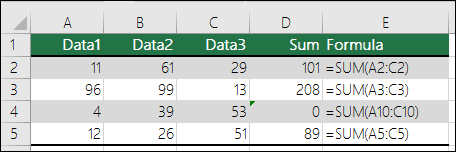
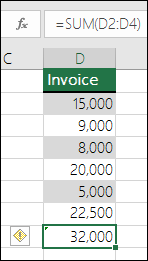
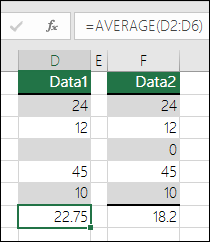

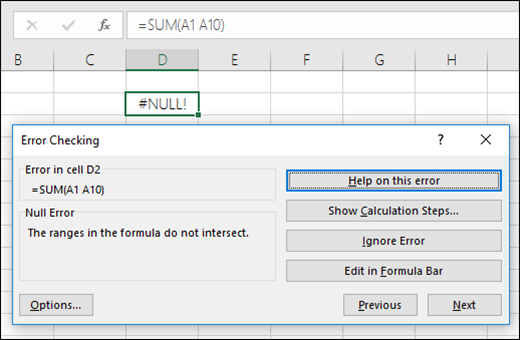
 that appears, and then click the option you want. The available commands differ for each type of error, and the first entry describes the error.
that appears, and then click the option you want. The available commands differ for each type of error, and the first entry describes the error.